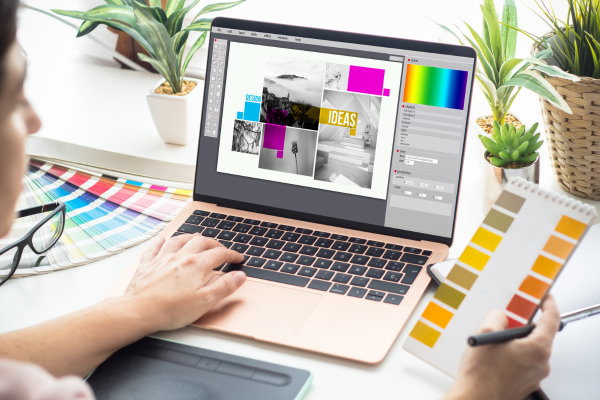Design is a powerful tool that shapes the world around us and influences how we interact with our environment. Whether you’re a professional designer or a passionate enthusiast, continuously refining and perfecting your design skills is crucial. In this article, we will delve into essential tips and tricks that will empower you to take your design creations to new heights of excellence and impact.
I. Understanding the Core Principles of Design
To create exceptional designs, it’s essential to have a deep understanding of the core principles that underpin effective visual communication. Explore the elements of design, such as color theory, typography, composition, balance, and contrast. Grasping the intricacies of these principles will allow you to make informed design decisions and create harmonious and visually captivating designs.
Color theory is the study of how colors interact and evoke emotions. By understanding the psychology of color, you can select the right color palette that conveys the intended message and elicits the desired response from your audience. Experiment with different color combinations, hues, and saturations to create designs that are visually appealing and emotionally impactful.
Typography is another critical aspect of design. It involves selecting appropriate typefaces, font sizes, and spacing to convey the tone and personality of your designs. Explore a variety of typefaces and experiment with different typographic compositions. Consider the legibility and readability of the chosen fonts, ensuring they align with the overall design aesthetic and effectively communicate the message.
II. Embracing a User-Centered Approach to Design
Design is not just about aesthetics; it’s about solving problems and meeting the needs of the end-users. Embrace a user-centered approach by immersing yourself in the world of your target audience. Conduct thorough user research, create user personas, and engage in usability testing to gain valuable insights into user behaviors and preferences. By truly understanding the users and their pain points, you can create designs that are intuitive, user-friendly, and tailored to their specific needs.
Empathy is a key aspect of user-centered design. Put yourself in the shoes of your users and strive to understand their goals, motivations, and frustrations. By empathizing with your audience, you can create designs that address their needs and provide meaningful solutions. Consider the context in which your design will be used and ensure that it fits seamlessly into the user’s workflow or experience.
Usability testing is a crucial step in the design process. Gather feedback from real users by conducting usability tests to identify any usability issues or areas for improvement. By observing how users interact with your designs, you can uncover insights that will inform iterative design refinements. Usability testing helps ensure that your designs are user-friendly, intuitive, and effective in meeting user needs.
III. Harnessing the Power of Visual Hierarchy
Visual hierarchy is a fundamental aspect of effective design. It allows you to guide the viewer’s attention and create a clear and engaging visual flow. Experiment with techniques such as size, color, contrast, and placement to establish a hierarchy that effectively communicates your intended message. By skillfully manipulating visual hierarchy, you can enhance the overall user experience and ensure that key elements are easily noticed and understood.
Size is a powerful tool in establishing visual hierarchy. Larger elements tend to grab attention and create a focal point, while smaller elements are perceived as less significant. Use size to emphasize important information or key elements in your designs. Consider the hierarchy within different design elements, such as headlines, subheadings, and body text, to guide the reader’s eye and create a clear hierarchy of information.
Color can also be used to create visual hierarchy. Bright and saturated colors tend to attract attention, while muted or neutral colors recede into the background. Use color strategically to draw attention to important elements or create visual associations between related elements. Consider using a limited color palette to maintain consistency and avoid overwhelming the viewer.
Contrast plays a vital role in establishing visual hierarchy. Contrast in color, brightness, or saturation can create a clear distinction between elements, making certain elements stand out. Experiment with contrasting colors or values to highlight important information or create a sense of depth and dimension in your designs.
Placement and proximity are essential in guiding the viewer’s eye and creating visual hierarchy. By placing important elements prominently or positioning them strategically within the design, you can ensure they receive the attention they deserve. Group related elements together to create visual associations and establish a clear relationship between them.
IV. Mastering the Art of Typography
Typography plays a significant role in design. It involves selecting and arranging typefaces, font sizes, line spacing, and letterforms to convey the intended message and establish a visual identity. Experiment with different typefaces and font combinations to find the perfect match for your designs.
Consider the characteristics of different typefaces, such as serif, sans-serif, script, or display fonts, and choose fonts that align with the tone and personality of your designs. Serif fonts are often associated with tradition, elegance, and formality, while sans-serif fonts convey a more modern, clean, and minimalist aesthetic. Script fonts exude elegance, fluidity, and sophistication, while display fonts make a bold statement and grab attention.
Font sizes and line spacing also play a role in typography. Use font sizes to create emphasis and hierarchy within your text. Larger font sizes can be used for headlines or important information, while smaller font sizes are ideal for body text or secondary content. Line spacing, also known as leading, affects the readability and legibility of your text. Experiment with different line spacing to find the optimal balance between readability and aesthetics.
V. Embracing the Beauty of Negative Space
Negative space, or whitespace, is an often-underappreciated aspect of design. Embrace the beauty of negative space by strategically incorporating it into your compositions. By allowing elements to breathe and giving them room to shine, you create a sense of elegance, simplicity, and focus. The skillful use of negative space enhances clarity, emphasizes key elements, and brings a sense of balance and sophistication to your designs.
Negative space provides visual relief and helps to create a sense of order and hierarchy within your designs. Use whitespace to separate elements, group related elements together, or establish a clear visual flow. By giving your designs room to breathe, you create a sense of openness and spaciousness that enhances the overall user experience.
VI. Consistency and Brand Identity
Consistency is key when it comes to effective design. Developing a cohesive visual language and maintaining consistency throughout your designs helps establish a strong brand identity and builds trust with your audience. Consider the following elements to ensure consistency in your designs:
Color palette: Use a consistent color palette that aligns with the brand’s identity and evokes the desired emotions. Create a style guide or color palette reference to ensure consistency across different design assets.
Typography: Establish a set of fonts and font styles that reflect the brand’s personality and use them consistently across various design materials. This includes headings, subheadings, body text, and other typographic elements.
Visual elements: Consistent use of icons, illustrations, and other visual elements strengthens brand recognition and reinforces the brand’s identity.
VII. Embracing Feedback and Iteration
Feedback is a valuable asset for growth and improvement as a designer. Seek constructive criticism from peers, mentors, and clients to gain fresh perspectives and identify areas for improvement. Actively listen to feedback and view it as an opportunity to learn, iterate, and refine your designs.
Feedback can come in many forms, including formal design critiques, user testing, or informal discussions with colleagues. Embrace feedback as an integral part of the design process and use it to iterate on your designs. Iteration involves making multiple versions or revisions of your design based on feedback and testing. By embracing feedback and iteration, you can refine your designs, uncover new possibilities, and create even more impactful and successful creations.
Conclusion
Design is a never-ending journey of exploration, creativity, and growth. By deepening your understanding of the core principles of design, embracing a user-centered approach, harnessing the power of visual hierarchy, mastering typography, embracing negative space, maintaining consistency, and embracing feedback and iteration, you can elevate your design work to new levels of excellence and perfection.
Remember, your design creations have the power to evoke emotions, solve problems, and make a lasting impact. By applying the tips and tricks shared in this article, you can unleash your full creative potential and create designs that resonate with your audience on a profound level.



